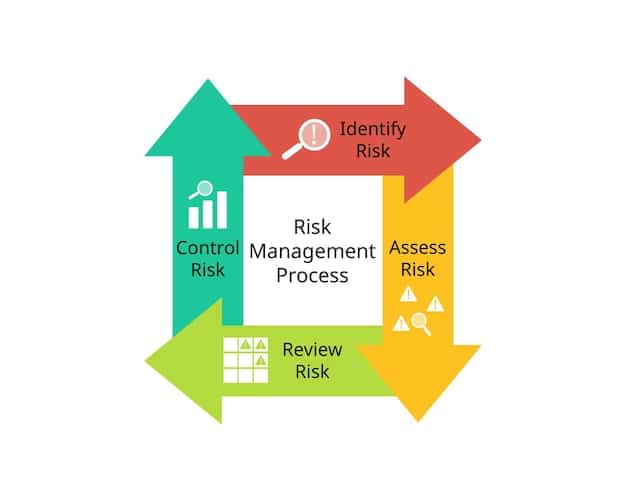Supply Chain Vulnerabilities: Assessing & Mitigating Third-Party Risks

Supply chain vulnerabilities, arising from third-party risks, demand comprehensive assessment and mitigation strategies to safeguard organizations from potential cyberattacks, data breaches, and operational disruptions.
In today’s interconnected digital landscape, businesses rely heavily on complex supply chains, making them increasingly susceptible to cyber threats. Addressing supply chain vulnerabilities exposed requires a proactive approach to assess and mitigate third-party risks, protecting your organization from potential disasters.
Understanding Supply Chain Vulnerabilities
Supply chain vulnerabilities stem from the intricate web of third-party vendors, suppliers, and partners organizations depend on. These vulnerabilities can be exploited by cybercriminals to gain access to sensitive data, disrupt operations, or launch attacks on your primary systems.
The Expanding Threat Landscape
The escalating frequency and sophistication of cyberattacks targeting supply chains highlight the urgent need for robust security measures. Addressing these threats proactively is crucial for organizational resilience.
Common Vulnerabilities in Supply Chains
Understanding the common weaknesses is the first step toward securing your supply chain. This includes vulnerabilities in software, hardware, and human processes.

Below are key areas where vulnerabilities typically arise:
- Software vulnerabilities: Exploitable flaws in third-party software components, libraries, and applications.
- Hardware vulnerabilities: Security weaknesses in hardware devices, components, or firmware used within the supply chain.
- Data security vulnerabilities: Risks associated with the storage, transmission, and processing of sensitive data by third-party vendors.
Identifying and mitigating these vulnerabilities involves continuous monitoring, regular security audits, and the implementation of stringent security protocols.
In conclusion, grasping the nature and sources of supply chain vulnerabilities is crucial for developing effective strategies to protect your organization from potential cyber threats.
Assessing Third-Party Risks
Assessing third-party risks is paramount to understanding the cybersecurity posture of your supply chain. This begins with identifying all third-party vendors and partners, subsequently evaluating their security practices.
Identifying Key Third-Party Relationships
Start by mapping out your entire supply chain ecosystem, documenting all entities that have access to your systems, data, or physical locations. This includes software vendors, cloud service providers, and even logistics companies.
Evaluating Security Practices
Once you’ve identified your third-party relationships, the next step is to evaluate their security practices. This can be achieved through questionnaires, security audits, and penetration testing.
Effective risk assessment involves:
- Security questionnaires: Distributing questionnaires to third-party vendors to gather information about their security policies, procedures, and technologies.
- Security audits: Conducting on-site or remote audits of third-party security controls to verify compliance with industry standards and best practices.
- Penetration testing: Simulating cyberattacks on third-party systems to identify vulnerabilities and assess the effectiveness of security measures.
Regular reassessments should be conducted to ensure that third-party vendors maintain acceptable security standards in a constantly changing threat environment.

Therefore, third-party risk assessment is an ongoing process that integrates due diligence, continuous monitoring, and proactive risk mitigation strategies.
Developing a Mitigation Strategy
Developing a robust mitigation strategy is your next line of defense after assessing your supply chain risks. Mitigation involves implementing controls to minimize the impact of potential vulnerabilities.
Key Components of a Mitigation Strategy
To effectively protect your supply chain, your mitigation strategy should include several key components. These include policy development, security controls, and incident response planning.
Implementing Security Controls
Security controls are measures designed to reduce the likelihood and impact of cyberattacks. These controls can be technical, administrative, or physical in nature.
Effective implementation involves:
- Access controls: Restricting access to sensitive data and systems on a need-to-know basis, using strong authentication methods such as multi-factor authentication.
- Data encryption: Encrypting data at rest and in transit to protect it from unauthorized access or disclosure.
- Network segmentation: Dividing the network into isolated segments to limit the spread of cyberattacks and prevent lateral movement.
By implementing a comprehensive mitigation strategy, organizations can significantly reduce their exposure to supply chain vulnerabilities and protect their critical assets.
To summarize, a well-designed mitigation strategy is crucial for minimizing the impact of potential cyber threats and enhancing the overall cybersecurity posture of the supply chain.
Enhancing Third-Party Security Protocols
Enhancing third-party security protocols is crucial for maintaining a secure and resilient supply chain. This involves enforcing robust security standards and ensuring compliance through regular monitoring.
Enforcing Strict Security Standards
Set clear expectations for third-party security practices by establishing comprehensive security standards. These standards should be based on industry best practices, regulatory requirements, and your organization’s risk tolerance.
Establish robust security standards, including:
- Data protection standards: Mandating the implementation of specific data protection measures, such as encryption, data loss prevention (DLP), and access controls.
- Incident response requirements: Requiring third-party vendors to have well-defined incident response plans in place and to promptly report security incidents to your organization.
- Compliance requirements: Ensuring that third-party vendors comply with relevant industry standards and regulations, such as GDPR, HIPAA, or PCI DSS.
Monitoring and Auditing Compliance
Create a framework for monitoring third-party compliance with security standards.
By taking these steps, you can significantly enhance the security of your supply chain and reduce the risk of supply chain vulnerabilities.
Therefore, continuously improving third-party security protocols is critical for mitigating risks associated with external vendors and partners.
Incident Response and Recovery Planning
Incident response and recovery planning is an important aspect for minimizing the impact of supply chain vulnerabilities. A well-defined plan ensures a coordinated and effective response to security incidents.
Creating an Incident Response Plan
Develop an incident response plan that outlines roles, responsibilities, and procedures for detecting, analyzing, containing, and recovering from security incidents. This plan should be tailored to the specific risks and vulnerabilities within your supply chain.
Testing and Refining the Plan
Regularly test and refine your incident response plan through simulations, table-top exercises, and real-world scenarios. This helps identify gaps in the plan and ensures that incident response teams are well-prepared to handle security incidents effectively.
Key components of incident response and recovery planning:
- Containment strategies: Actions taken to isolate and contain security incidents, preventing them from spreading to other systems or networks.
- Recovery procedures: Steps involved in restoring systems, data, and operations to their normal state after a security incident.
- Communication protocols: Guidelines for communicating with stakeholders, including third-party vendors, regulatory authorities, and customers, during and after a security incident.
By having a well-defined and regularly tested incident response plan, organizations can minimize the impact of security incidents and ensure a swift recovery.
In conclusion, proactive incident response and recovery planning is essential for mitigating the potential damage from supply chain security breaches.
Continuous Monitoring and Improvement
Continuous monitoring and improvement is essential for maintaining a resilient and secure supply chain. This proactive approach helps organizations adapt to evolving threats and improve their overall security posture.
Establishing a Continuous Monitoring Program
Implement a continuous monitoring program to track key security metrics, identify emerging threats, and assess the effectiveness of security controls. This program should include automated monitoring tools, regular vulnerability scans, and ongoing risk assessments.
Regular Security Audits
Conduct regular security audits to verify compliance with security standards, identify vulnerabilities, and assess the effectiveness of security controls. These reviews should include both internal systems and third-party vendors to ensure comprehensive coverage.
Key areas include:
- Vulnerability Management: Regular scans and assessments to identify and remediate security weaknesses.
- Threat Intelligence: Staying informed about current and emerging threats to proactively defend against attacks.
- Performance Metrics: Tracking security metrics to measure the effectiveness of controls and identify areas for improvement.
Through continuous monitoring and regular audits, businesses can promptly address security gaps and stay ahead of potential threats.
Therefore, ongoing vigilance and adaptation are crucial for sustaining a robust and secure supply chain.
| Key Point | Brief Description |
|---|---|
| 🛡️ Identifying Risks | Pinpointing vulnerabilities in your supply chain early. |
| 🔒 Security Protocols | Enforcing strict standards with all third-party vendors. |
| 🚨 Incident Response | Having plans ready for quick action after any breach. |
| 🔄 Continuous Monitoring | Always improving security with regular checks. |
Frequently Asked Questions (FAQ)
▼
Common vulnerabilities include insecure software, weak security protocols among third-party vendors, and lack of visibility into the security practices of suppliers.
▼
Third-party risk assessment identifies vulnerabilities in your supply chain by evaluating security postures of vendors, ensuring compliance, and enabling targeted mitigation strategies.
▼
A mitigation strategy helps reduce the impact of security breaches by isolating threats, encrypting data, and establishing clear access controls and security policies.
▼
An incident response plan should outline roles, procedures for detecting and containing incidents, steps for data recovery, and protocols for communication to minimize impact.
▼
Continuous monitoring enables timely detection of potential threats, assesses the effectiveness of security, ensures compliance, and helps rapidly adapt to evolving cyber threats.
Conclusion
In conclusion, addressing supply chain vulnerabilities exposed by third-party risks requires a comprehensive and continuous approach. By understanding the risks, assessing your vendors, developing mitigation strategies, and maintaining constant vigilance, you can protect your organization from potential cyber threats and ensure a resilient and secure supply chain.





